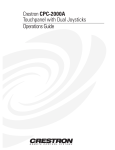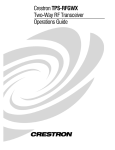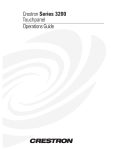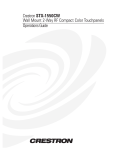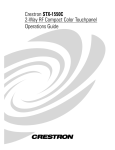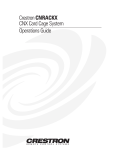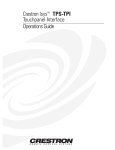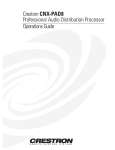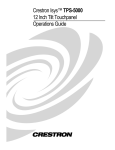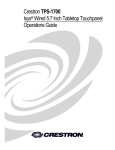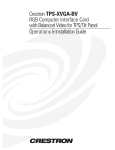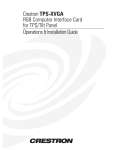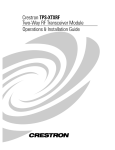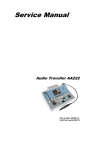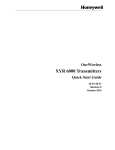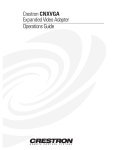Download Crestron STX-1600C Specifications
Transcript
CRESTRON Contents Series STX Touchpanels 1 Description................................................................................................................................. 1 Functional Description ................................................................................................ 1 Physical Description.................................................................................................... 3 Configuration Differences........................................................................................... 4 Leading Specifications............................................................................................................... 5 Setup .......................................................................................................................................... 7 Recommended Touchpanel Cleaning.......................................................................... 7 Battery Usage .............................................................................................................. 8 Identity Codes ............................................................................................................. 9 Hardware Hookup ....................................................................................................... 9 Configuring the Touchpanel.................................................................................................... 10 Calibration Menu....................................................................................................... 10 Diagnostics Menu...................................................................................................... 11 Setup Menu ............................................................................................................... 11 Programming with SIMPL™ Windows ............................................................................... 16 How the Program Works........................................................................................... 16 How to Create the Program ....................................................................................... 17 Reserved Join Numbers............................................................................................. 20 Problem Solving ...................................................................................................................... 21 Troubleshooting ........................................................................................................ 21 Further Inquiries........................................................................................................ 23 Appendix ................................................................................................................................. 24 Overview ................................................................................................................... 24 VT Pro Project........................................................................................................... 24 SIMPL Program ........................................................................................................ 25 Conclusion: How the Example Works ...................................................................... 26 Software License Agreement................................................................................................... 27 Return and Warranty Policies.................................................................................................. 29 Merchandise Returns / Repair Service ...................................................................... 29 CRESTRON Limited Warranty ................................................................................ 29 Operations Guide - DOC. 5716A Contents • i CRESTRON Series STX Touchpanels Description Functional Description The Series STX touchpanels, also known as Spectrum touchpanels, are touchscreen control panels of various sizes for the CRESNET remote control system (herein referred to as the CRESNET system). The Spectrum family of touchpanels act as a transceiver that offers long range, radio frequency (RF), two-way communication with the CNRFGWX, to provide dynamic onscreen feedback for real-time confirmation of commands. Up to 15 Spectrum touchpanels can communicate with one CNRFGWX. Crestron’s exclusive RF engineering permits transmission over extended ranges and utilizes spread spectrum technology. Signals can travel up to 1000 feet to and from the transceiver, even through walls. Spread spectrum eliminates the risk of signal ‘drop-out’ by automatically scanning for the best frequency. There is no need to concern yourself about loss of power; all STX touchpanels offer multiple power options. Two extra-long life, rechargeable nickel-cadmium (NiCad) battery packs slip into the unit to handle any situation from anywhere in the range without wires. Power backup is available from a supplied power pack that plugs into the base of the unit. STX touchpanels also have a network port to provide power backup via the network. Simply plug the CRESNET network wire into the port to bypass RF transmission and communicate via a hardwire on the fly. Enjoy uninterrupted control while simultaneously recharging the battery packs. Have a comment about Crestron’s software? Software Direct software related suggestions and/or complaints to Crestron via email ([email protected]). Do not forward any queries to this address. Instead refer to “Further Inquiries” on page 23 for assistance. VisionTools™ Pro (VT Pro), a design and programming Windows-based software, permits the creation of unlimited control screen variations incorporating two and three-dimensional graphics and text. A set of pages which make up a project can be designed for each STX touchpanel application. Each page contains objects such as custom control graphics, two and three-dimensional buttons, sliders, and digital readouts which allow the user to interface with the control system. The project is uploaded to the touchpanel and programmed into the flash PROM. The touchpanel uses the programmed project until another set is uploaded from the PC. The PC may be disconnected from the rack or panel except during reprogramming. For additional software information, consult the VT Pro help file. Operations Guide - DOC. 5716A Series STX Touchpanels • 1 CRESTRON Position Lock Button The position lock button is centrally located at the front of the STX touchpanel base. These touchpanels permit incremental angle positions indicated by audible clicks. Range of motion is adjustable for user comfort and can vary depending on the STX configuration. Thus the user can position the touchscreen to a comfortable angle, just as a microphone can be repositioned for each speaker. The comfortable angle is herein referred to as user position. The position lock guarantees that once a user position is established or locked, the angle will not degrade from repeated presses on the touchscreen. The touchscreen is free to move up from the horizontal to an incremental angle. Grasp the touchscreen with a hand at each side and gently tilt up to a comfortable position. To activate position lock, slightly reverse the motion until the touchpanel stops moving. Correct hand placement is shown below. The touchscreen is now set into user position. Hand Position for Tilting Touchpanel to Vertical Once in user position, position lock is activated which means the touchscreen can not be forced to the horizontal position without depressing the position lock button. The touchscreen is still free to tilt up; a new user position is established at each increment or audible click. The position lock button needs to be depressed before the touchscreen can be returned to the horizontal position. To depress the button, slightly position the touchscreen in the vertical direction with two hands, avoiding any tilting. The position lock button can be depressed with one hand; the touchscreen can be tilted down to the horizontal position with the other, shown below. Hand Position for Tilting Touchpanel to Horizontal 2 • Series STX Touchpanels Operations Guide - DOC. 5716A CRESTRON Physical Description The touch sensitive viewing screen is located on the front of each STX touchpanel. The electronic hardware is housed in a high impact, black molded plastic enclosure. These touchpanels are designed to be placed on a counter and possess a hinged base which can tilt (angle depends on STX configuration). Depress the position lock button located at the front of the base when pivoting the touchpanel to the horizontal position. The size of the base, shown below, is exactly the same for all STX configurations; only the distance between the two hinges is smaller for the smaller touchscreen. Physical View of STX Touchpanel Base TOP VIEW OF BASE WITHOUT TOUCHSCREE Two battery packs must be inserted into the base of the touchpanel for wireless operation. The battery compartment door is located on the right side (when facing the touchscreen) of the base, shown below. Two connectors are located on the left side (when facing the touchscreen) of the base. The DC power socket connector is used to supply external power via the supplied 24 VDC power pack. The network connector is a 6-pin, 6-position RJ11 modular jack. A network wire must be attached to the touchpanel when uploading a program. The network wire provides power. Side Views of STX Touchpanel Base LEFT SIDE VIEW OF STX TOUCHPANEL RIGHT SIDE VIEW OF STX TOUCHPANEL NOTE: Most 4-conductor phone cables are wired in a crisscross fashion and are not compatible with Crestron equipment. NOTE: If the power pack and the network wire is attached at the same time, power is drawn from the power pack. The touchpanel does not load the network power. Operations Guide - DOC. 5716A Series STX Touchpanels • 3 CRESTRON Power buttons and LED indicators, shown below, are located on the touchpanel base just left of the position lock button. Two membrane buttons, OFF and ON, can be used to deactivate and activate the touchpanel when needed. The ON button has a LED behind the membrane. It illuminates when the touchpanel is active. Three other LEDs are positioned to the right of the membrane buttons: RF SIG, BATTERY LOW, and BATTERY CHG. RF SIG illuminates when the touchpanel communicates with the CNRFGWX transceiver. BATTERY LOW illuminates when the battery packs in the touchpanel have a low charge. BATTERY CHG illuminates while the low or discharged battery packs inserted in the touchpanel are slow charged; assuming the touchpanel is powered from the external power pack or the network. Power Switch and Indicators (Close-Up) Configuration Differences There are three Series STX configurations available and selection depends on color versus grayscale display, display size, and memory. A configuration is defined by an alphanumeric suffix after STX. Refer to the table shown below for a concise listing of each Series STX configuration. Following the table, front views of each STX touchpanel are shown. Series STX Touchpanel Configurations DISPLAY DIAGONAL VIEW SCREEN MEMORY STX-1600C 256 Color 5.7 in (14.5 cm) 768 Kbytes STX-3000 256 Grayscale 9.4 in (23.9 cm) 256 Kbytes STX-3500C 256 Color 9.4 in (23.9 cm) 1 Mbyte CONFIGURATION Front View of the STX-1600C 4 • Series STX Touchpanels Operations Guide - DOC. 5716A CRESTRON Front View of the STX-3000 Front View of the STX-3500C Leading Specifications The table below and on the next page provides a summary of leading specifications for the STX touchpanels. Dimensions and weight are rounded to the nearest hundredth unit. Operations Guide - DOC. 5716A Series STX Touchpanels • 5 CRESTRON Leading Specifications of the STX Touchpanels SPECIFICATION DETAILS Power Requirements STX-1600C & STX-3000 12 Watts, 24 VDC 0.5 Amp STX-3500C 24 Watts, 24 VDC 1.0 Amp Power Options 2 Rechargeable NiCd Battery Packs CRESNET Network Power AC Adapter (power pack - supplied) Communications RF: Bidirectional Spread Spectrum 2.4 GHz (1000-foot range). Requires one CNRFGWX transceiver per 15 STX series touchpanels. CRESNET: 6-wire, RJ-type connectors; allows wired network interface in addition to wireless operation. Only 4 wires are required; pins 1 and 6 are not connected. SIMPL Windows Version 1.21.04 or later* CNX Operating System Version 5.01.09x or later CNX Monitor Version 2.00 or later CNMS, CNRACK, CNLCOMP Version 3.16.08 or later Operating System ST-CP Operating System Version 4.00.29 or later ST-CP Monitor Version 1.29 or later VisionTools Pro (VT Pro) Version 1.1.3 or later* Memory STX-1600C 768 Kbytes flash memory for display STX-3000 256 Kbytes flash memory for display STX-3500C 1 Mbyte flash memory for display Dimensions & Weight for STX-1600C Height: 6.14 in (15.59 cm) - with 80 degree tilt (without battery packs) Width: 7.90 in (20.07 cm) Depth: 9.03 in (22.94 cm) Weight: 4.94 lb (2.54 kg) Dimensions & Weight for STX-3000 Height: 8.70 in (22.09 cm) - with 75 degree tilt (without battery packs) Width: 11.21 in (28.48 cm) Depth: 9.03 in (22.94 cm) Weight: TBD lb (TBD kg) Dimensions & Weight for STX-3500C Height: 9.29 in (23.59 cm) - with 70 degree tilt (without battery packs) Width: 11.29 in (28.67 cm) Depth: 9.03 in (22.94 cm) Weight: 7.40 lb (3.36 kg) View Screen Dimensions * 6 • Series STX Touchpanels Height x Width STX-1600C 3.50 in (9.00 cm) x 4.70 in (11.90 cm) STX-3000 5.80 in (14.70 cm) x 7.70 in (19.60 cm) STX-3500C 6.20 in (15.75 cm) x 8.30 in (21.08 cm) The latest software versions can be obtained from the Software Downloads page of Crestron’s website (www.crestron.com). New users are required to register in order to obtain access to the FTP site. Operations Guide - DOC. 5716A CRESTRON Leading Specifications of the STX Touchpanels (Continued) SPECIFICATION DETAILS View Screen Resolution STX-1600C 320 x 240 pixels STX-3000 & STX-3500C 640 x 480 pixels View Screen Display STX-1600C Passive Matrix Color LCD STX-3000 Passive Matrix LCD STX-3500C Active Matrix Color LCD View Screen Illumination Edgelit Fluorescent View Screen Touch Screen Resistive Membrane As of the date of manufacture, the Series STX touchpanels have been tested and found to comply with specifications for CE marking. NOTE: Equipment has been tested and found to comply with the limits for a Class B digital device, pursuant to part 15 of the FCC Rules. These limits are designed to provide reasonable protection against harmful interference in a residential installation. The equipment generates, uses and can radiate radio frequency energy and, if not installed and used in accordance with the instructions, may cause harmful interference to radio communications. However, there is no guarantee that interference will not occur in a particular installation. If this equipment does cause harmful interference to radio or television reception, which can be determined by turning the equipment off and on, the user is encouraged to try to correct the interference by one or more of the following measures: Reorient or relocate the receiving antenna. Increase the separation between the equipment and receiver. Connect the equipment into an outlet on a circuit different from that to which the receiver is connected. Consult the dealer or an experienced radio/TV technician for help. Setup WARNING: To avoid shock hazard and possible damage to the unit, do not use touchpanel in rain or expose it to unnecessary moisture. Recommended Touchpanel Cleaning Keep the surface of the touchscreen free of dirt, dust, or other materials that could degrade optical properties. Long term contact with abrasive materials can scratch the surface which may detrimentally affect image quality. Operations Guide - DOC. 5716A Series STX Touchpanels • 7 CRESTRON For best cleaning results, use a clean, damp, non-abrasive cloth with any commercially available non-ammonia glass cleaner. Surrounding plastic enclosure may not provide a complete water-tight seal. Therefore, apply cleaning solution to the cloth rather than the surface of the touchscreen. Wipe touchscreen clean and avoid ingress of moisture beneath panels. Battery Usage The touchpanel can be powered via the supplied power pack or two battery packs, ST-BP. Location and orientation of the ST-BP are shown below. Complete the following steps in the order provided to insure proper installation. Battery Polarity TOP VIEW OF BASE WITHOUT TOUCHSCREEN (CUT-AWAY VIEW OF BATTERY COMPARTMENT WITH DOOR OPEN) RIGHT SIDE VIEW OF STX TOUCHPANEL WITH BATTERY COMPARTMENT DOOR OPEN CAUTION: Installing battery packs with the wrong polarity does not damage the touchpanel, but may result in damage to the battery packs if left in the battery compartment for extended periods. NOTE: Crestron’s ST-BP can be slow charged while in the battery compartment as long as the power pack is attached and plugged into an outlet or network power is supplied. It takes approximately 20 hours to slow charge a fully discharged ST-BP. There is no danger of over charging the ST-BP, so the power packs can be installed at all times. It only takes 2 hours to charge the ST-BP in Crestron’s battery charger, ST-BC (sold separately). 8 • Series STX Touchpanels 1. Verify that the touchpanel is resting on a level surface and there are no obstacles in front of the battery compartment door. 2. Lift the lever on the battery compartment door; the spring-loaded door pops open slightly on its hinge. 3. Fully open the battery compartment door and insert battery packs; observe polarity (as illustrated). 4. Close battery compartment door. Operations Guide - DOC. 5716A CRESTRON Identity Codes The STX touchpanels possess three distinct types of identity codes: NET ID, RF ID, and RF CHANNEL. These codes are assigned to the unit from the Interface Menu and RF SETTINGS screen when you configure the touchpanel. Refer to “Interface” on page 12. For the touchpanel to be identified within the CRESNET system, these assignments must match assignments made in the SIMPL Windows program (for NET ID and RF ID) and the assignment made for the CNRFGWX in the Performance Viewport via VT Pro or SIMPL Windows (for RF CHANNEL). Refer to “Programming with SIMPL™ Windows” on page 16. NET ID All network equipment and user interface within the CRESNET system requires a unique network identity code (NET ID). This code is vital to ensure proper communication when uploading VT Pro projects to the wired touchpanel. These codes are recognized by a two-digit hexadecimal number from 03 to FE. The NET ID of the unit must match the NET ID specified in the SIMPL Windows program. RF ID Every wireless STX touchpanel communicating with a CNRFGWX requires a unique RF identity code (RF ID). This code is necessary to secure RF communications such that controls can be activated from the touchpanel when it is no longer hardwired to the system. There are 15 useable codes for STX touchpanels ranging from 1 to F (hexadecimal number). The RF ID of the unit must match the RF ID specified in the SIMPL Windows program. RF CHANNEL Every wireless STX touchpanel communicating to the network via a specific CNRFGWX transceiver must have a RF CHANNEL that matches the RF CHANNEL of the CNRFGWX. Each CNRFGWX in a system requires a unique RF CHANNEL. There are 16 possible RF CHANNELS ranging from 0 to F (hexadecimal number). The RF CHANNEL of the unit must match the RF CHANNEL assigned to the CNRFGWX via the Performance Viewport in VT Pro or SIMPL Windows. Hardware Hookup The extent of hooking up a STX touchpanel only involves connecting the unit to the network when uploading a project to the touchpanel. Depending on the control system, the hookup may implement the CN-RJ11 (supplied); refer to the hardware hookup diagrams below for proper connections when uploading the project. STX Touchpanel Hardware Hook-Up Diagram (Implementing the CN-RJ11) NOTE: UNITS IN THIS ILLUSTRATION ARE NOT DRAWN TO SCALE. LEFT SIDE VIEW OF STX TOUCHPANEL POWER PACK (OPTIONAL) CONTROL SYSTEM Operations Guide - DOC. 5716A PC SERIAL PORT Series STX Touchpanels • 9 CRESTRON STX Touchpanel Hardware Hook-Up Diagram (No CN-RJ11) NOTE: UNITS IN THIS ILLUSTRATION ARE NOT DRAWN TO SCALE. LEFT SIDE VIEW OF STX TOUCHPANEL POWER PACK (OPTIONAL) CONTROL SYSTEM PC SERIAL PORT Configuring the Touchpanel It may be necessary to make adjustments or configure the touchpanel due to utilization or a particular appearance chosen by the user. To configure STX touchpanels, it is necessary to access a series of setup screens prior to viewing runtime screens that are loaded into the touchpanel for normal operation. The Main Menu for configuring the touchpanel appears when a finger is held to the touchscreen as power is applied. Remove your finger when the message “SETUP MODE” appears on the touchscreen. Holding a finger to the touchscreen for five seconds after the “SETUP MODE” message is displayed sets the brightness to high and the contrast to a safe value (STX-3500C does not offer contrast adjustment). NOTE: The firmware (required for configuring the touchpanels) is identical for the STX-3000 and STX-3500C. Therefore, all screens, except for one (contrast adjustment on the Setup Menu), are identical. Firmware for the STX-1600C differs completely, except for the Main and Calibration Menus. In this guide, differing screens are shown side-by-side with STX-1600C screens on the left and the STX-3000 and STX-3500C screens on the right. The Main Menu, shown after this paragraph, displays four buttons: TOUCH SCREEN CALIBRATION, SAVE SETUP AND RUN PROGRAM, SETUP, and DIAGNOSTICS. Main Menu Calibration Menu Calibration of the touchscreen is required if the active touch area of a button does not coincide with the button’s image. Select the TOUCH SCREEN CALIBRATION button on the Main Menu to display the Calibration Menu, shown on the next page. The Calibration Menu offers the choice to initiate calibration with 10 • Series STX Touchpanels Operations Guide - DOC. 5716A CRESTRON the Perform Calibration button or return to the previous screen with the Return to Main Menu button. Choose an option by touching the correct button. When touching the screen, be as accurate as possible. Calibration Menu If you proceed to calibrate the touchpanel, the screen prompts you with the message “Touch Screen Calibration Menu” nearly centered on the display. Another message, “Touch Upper Left Corner”, appears in the upper left corner. Touch the corner of the screen to initiate calibration. Another message, “Touch Lower Right Corner”, appears in the lower right corner. Touch the corner of the screen to return to the Main Menu and terminate calibration. Diagnostics Menu The DIAGNOSTICS button from the Main Menu should only be used under supervision from a Crestron technical support representative during telephone support. The options available from the Diagnostics Menu, shown after this paragraph, are numeric in nature and their interpretation is beyond the scope of this guide. Select the RETURN button, located at the lower right corner, to get back to the Main Menu. Diagnostics Menu Setup Menu To obtain the Setup Menu, shown after this paragraph, select the SETUP button from the Main Menu. Many options for setting touchpanel parameters are available from the Setup Menu and are explained in the following paragraphs. After setup parameters have been set, select the RETURN button, located at the lower right corner of the Setup Menu. Operations Guide - DOC. 5716A Series STX Touchpanels • 11 CRESTRON Setup Menu NOTE: Since the same Setup Menu used for the STX-3000 and STX-3500C is used for Crestron’s wired panels as well, the RS-232 button - although shown, is not functional when configuring STX touchpanels. Interface The touchpanel communicates with a CRESNET system to activate other controls or to display feedback from components within the system. The communication interface must be correctly specified or communication will not occur. To set communication parameters select the INTERFACE button from the Setup Menu to display the Interface Menu, shown below. Interface Menu NOTE: Since the same Interface Menu used for the STX-1600C is used for Crestron’s wired panels as well, the RS232 SETTINGS button - although shown, is not functional when configuring the STX-1600C touchpanel. The CRESNET network identity number (NET ID) is represented by # # for illustrative purposes on the Interface Menu. NET ID is the two-digit hexadecimal number that can range from 03 to FE and must correspond to the NET ID set in the Performance Viewport via VT Pro or SIMPL Windows software. Matching NET IDs between STX touchpanels and a VT Pro program is required if new touchpanel screens are to be loaded. Matching NET IDs between STX touchpanels and a SIMPL Windows program is required if data is to be successfully transferred during wired operation. The NET ID of each STX touchpanel is factory set to 03. Two side-by-side buttons, < CRESNET ID and CRESNET ID >, decrease and increase the NET ID by one, respectively. The touchpanel usually communicates with a CRESNET system. Occasionally the touchpanel can be used in a local demo mode where it merely displays various menus, but does not communicate with the CRESNET II system. In local mode, the directory buttons change pages, but buttons requiring feedback do not work. Two buttons on the Interface Menu, LOCAL and CRESNET II, determine communication mode. Select LOCAL to set the touchpanel into demo mode and 12 • Series STX Touchpanels Operations Guide - DOC. 5716A CRESTRON CRESNET II for normal CRESENT communication mode. Text within the selected button changes color from black to red (for STX-1600C) or light gray (for STX3000 and STX-3500C). Communication mode is factory set to CRESNET II. Two side-by-side buttons on the Interface Menu (for STX-3000 and STX-3500C), RS-232 ON and RS-232 OFF, located just above the RETURN button. Text within the selected button changes color from black to light gray. Since there is no RS-232 port on STX touchpanels, verify that the RS-232 OFF button is selected. NOTE: Do not set the RF ID to “0”; it is not supported in SIMPL Windows. The RF SETTINGS button opens the RF SETTINGS screen, shown below. The radio frequency identity number (RF ID) is displayed in the RF SETTINGS screen. The RF ID must match the identity code in the SIMPL Windows program and is identified by a hexadecimal number in the range from 0 to F. In the illustration, the RF ID is shown with a setting of “A”. The DOWN and UP buttons associated with the RF ID field decrease and increase the RF ID by one, respectively. RF Settings Screen NOTE: Due to network traffic, the STX touchpanel may not respond to a network upload. To compensate, access the setup screens (refer to “Configuring the Touchpanel” on page 10) to provide exclusive upload communication between the STX touchpanel and the control system. The RF CHANNEL of the STX touchpanel must be identical to the RF CHANNEL of the CNRFGWX to which it communicates. The radio frequency channel (RF CHANNEL) is displayed in the RF SETTINGS screen. The RF CHANNEL is identified by a hexadecimal number in the range from 0 to F. In the illustration, the RF CHANNEL is shown with a setting of “F”. The DOWN and UP buttons associated with the RF ID field decrease and increase the RF ID by one, respectively. “Many” refers to using more than 16 CNRFGWXs in the same building. Channels may be reused if the CNRFGWXs are placed several floors apart and low power is selected. Two buttons, Low Power and High Power, determine the radio’s power. It is recommended that the High Power button be enabled; indicated with red text (for STX-1600C) or light gray text (for STX-3000 and STX-3500C). This recommendation is acceptable in all cases, except in an environment where there are many CNRFGWXs installed or when the touchpanel is operating within five feet of the CNRFGWX. NOTE: The power setting of the CNRFGWX is separate from the power setting of the STX touchpanel. The two settings do not have to match. Selection depends on operation in a given environment. NOTE: After a change is made to the RF SETTINGS screen, save setup and cycle power (turn unit off and on again) for settings to become effective. Select the RETURN button on the Interface Menu after interface parameters have been set. Operations Guide - DOC. 5716A Series STX Touchpanels • 13 CRESTRON Contrast NOTE: Contrast adjustment is not available on the STX-3500C configuration. Screen contrast may need to be altered because of ambient light conditions, panel temperature, or personal preference. Two contrast buttons, Contrast << and Contrast >> (Cont << and Cont >> for the STX-1600C), on the Setup Menu may be held down for continuous and smooth adjustment of the screen. Brightness Screen brightness may need to be altered because of ambient light conditions or personal preference. Three brightness buttons, BRIGHTNESS LOW (BRT LOW for the STX-1600C), BRIGHTNESS MED (BRT MED for the STX-1600C), and BRIGHTNESS HI (BRT HI for the STX-1600C), on the Setup Menu may be selected to assign the backlight setting. Panel Tracking NOTE: The panel tracking feature works best when the touchpanel is wired to the CRESNET system. Crestron does not recommend use of this feature when the touchpanel communicates via RF. Panel tracking is a useful communication feature between touchpanels when more than one touchpanel exists on the network. Panel tracking is enabled when the PANEL TRACKING button on the Setup Menu, is selected. Selection is indicated with red text (for STX-1600C) or light gray text (for STX-3000 and STX-3500C). When enabled, a given touchpanel maintains communication in such a way that a page change to any touchpanel on the network forces the same page change to all enabled touchpanels. Panel tracking is disabled when the PANEL TRACKING button is deselected (shown in black text). When disabled a given touchpanel does not respond to page changes made to other touchpanels on the network. Panel tracking is factory set with the PANEL TRACKING button deselected. Backlight Timeout Menu NOTE: Display backlight requires warm-up time. A display reaches 80% of its final level in five minutes and full brightness in 20 minutes. The touchpanel display hardware life can be lengthened by turning off the backlight when the touchpanel is inactive. The BACKLIGHT TIMEOUT button (on the STX-3000 and STX-3500C configurations) and MANAGE POWER button (on the STX-1600C configuration) on the Setup Menu reveals the Timeout screen, shown below. The length of touchpanel inactivity can be specified to minimize power utilization. Timeout Screen 14 • Series STX Touchpanels Operations Guide - DOC. 5716A CRESTRON BACKLIGHT TIMEOUT is displayed on the Timeout screen. This setting turns the backlight off when the touchpanel is inactive for the specified time (shown in minutes). When the touchpanel is activated, the last screen to be displayed reappears. A two minute BACKLIGHT TIMEOUT is shown in the illustration. Minutes can vary from 0 to 120, where 0 disables the timeout. Down and up arrow buttons (worded buttons, DOWN and UP, appear on the STX-1600C configuration) decrease and increase the timeout, respectively. To have the touchpanel return to the last screen displayed after the touchpanel encounters a POWER DOWN TIMEOUT, refer to the “Appendix” on page 24 for a programming remedy. STX POWER DOWN TIMEOUT is displayed on the Timeout screen. This setting turns off all power when the touchpanel is inactive for the specified time (shown in minutes). When the touchpanel is activated, the first page of the project appears. A 10 minute STX POWER DOWN TIMEOUT is shown in the illustration. Minutes can vary from 0 to 120, where 0 disables the timeout. Down and up arrow buttons (worded buttons, DOWN and UP, appear on the STX-1600C configuration) decrease and increase the timeout, respectively. NOTE: BACKLIGHT TIMEOUT should be set low to maximize battery pack life. However, STX POWER DOWN TIMEOUT should be set greater than BACKLIGHT TIMEOUT. Otherwise, the BACKLIGHT TIMEOUT is meaningless. NOTE: If network power is supplied to the touchpanel, the panel is capable of detecting network activity and does not power down when the STX POWER DOWN TIMEOUT is achieved. Recall that the purpose of the timeout is to maximize battery pack life. BACKLIGHT TIMEOUT is still functional. After timeout parameters have been set, touch the SAVE TIMEOUTS button in the lower left corner of the screen to save the new settings. Touch the RETURN button, located in the bottom right corner of the screen, to display the Setup Menu. Sound (for STX-1600C only) The SOUND button, located at the top right corner of the Setup Menu, is used to display the Sound Menu, shown below. Use this screen to activate audible key clicks. This feature is a useful feedback tool. Confirmation of a button press on a touchpanel is acknowledged by an audible click assuming this feature is enabled. To enable this feature, verify that the KEYCLICK ON button is active (red). An active KEYCLICK OFF button disables the feature. Volume of the audible click is controlled with the VOLUME UP and VOLUME DOWN buttons. The unit is factory set with the sound on. Sound Menu Save Setup It is advisable to regularly save setup parameters if the user is satisfied with the settings. If parameters are saved, the settings are restored in the event of a power failure. The SAVE SETUP button located on the Setup Menu (STX-3000 and STXOperations Guide - DOC. 5716A Series STX Touchpanels • 15 CRESTRON 3500C configurations only) may be selected at any time to save setup parameters. The button text changes color from black to light gray while in save mode. For STX1600C, use the SAVE SETUP AND RUN PROGRAM button on the Main Menu. Return Select the RETURN button, located at the lower right corner of the Setup Menu, after setup parameters have been set. Programming with SIMPL™ Windows NOTE: VisionTools Pro (VT Pro) is a Windows compatible software package for creating Crestron touchpanel screen designs. Refer to “Software” on page 1 for additional details regarding VT Pro. SIMPL (Symbol Intensive Master Programming Language) is an easy-to-use programming language that is completely integrated and compatible with all Crestron system hardware. The objects that are used in SIMPL are called symbols. SIMPL Windows offers drag and drop functionality in a familiar Windows® environment. SIMPL Windows is Crestron's software for programming Crestron control systems. It provides a well-designed graphical environment with a number of workspaces (i.e., windows) in which a programmer can select, configure, program, test, and monitor a Crestron control system. The next two subsections describe a sample SIMPL Windows program that utilizes a STX touchpanel. The first subsection details how the sample program works with a textual description and block diagram. The second subsection provides a broad description of how to actually create the SIMPL Windows program. NOTE: The following description assumes that the reader has knowledge of SIMPL Windows. If not, please refer to the extensive help information provided with the software. NOTE: There is no need to recreate the sample SIMPL Windows program. A copy of this program is available from Crestron’s ControlCD (version 5.1 and later). Search for the STX1600C.SMW project in the SIMPL Windows Example Base. NOTE: The sample in the next two sections utilize the STX-1600C configuration. This is done as an example only. The SIMPL Windows Example Base also contains .SMW projects for the other STX touchpanels (STX-3000.SMW, STX3500C.SMW). How the Program Works A basic STX-1600C SIMPL program is shown on the next page in block diagram form. For this example, the STX-1600C in a simple volume control application where UP and DOWN ramp a bargraph to an ST-VC, volume/tone control module, with a time interval of five seconds. It also shows digital, analog, and serial feedback to the panel. When UP or DOWN is pressed, the buttons highlight for as long as they are pressed. The bargraph moves up or down as the UP or DOWN buttons are pressed. Then MUTE is pressed, Channel A of the ST-VC is muted and the text 16 • Series STX Touchpanels Operations Guide - DOC. 5716A CRESTRON “MUTED” is sent to the touchpanel. When the ST-VC is unmuted, a space is sent to the touchpanel. Block Diagram of STX-1600C How to Create the Program Configuration Manager Use the Configuration Manager workspace (Project | Configure System) in SIMPL Windows to select and configure all the devices that need to be included into the system. For this example, add a CNRFGWX and ST-VC to the system. The NET ID of each device must be set as shown below and on the next page. NOTE: SIMPL Windows v1.21.04 or later is required to program the control system containing a STX-1600C touchpanel. If using an earlier version of SIMPL Windows, Crestron recommends a SIMPL Windows and operating system upgrade. The latest version can be obtained from the Software Downloads page of Crestron’s website (www.crestron.com). New users are required to register in order to obtain access to the FTP site. Network System View of CNRFGWX in SIMPL Windows’ Configuration Manager Operations Guide - DOC. 5716A Series STX Touchpanels • 17 CRESTRON Network System View of ST-VC in SIMPL Windows’ Configuration Manager Next, add the STX-1600C to the system. Click once on the CNRGWX icon in the Network System View to add the “RFX Address” window to the Detail System View. Drag and drop the STX-1600C icon from the Device Library to the desired RFX Address (0A in this example, as shown below). “RFX Address” Window Programming Manager Use the Programming Manager workspace (Project | Program System) in SIMPL Windows to select symbols and assign their respective signals. For this example, a two-way wireless touchpanel and ST-VC symbol were added automatically when the devices were added to the system in the Configuration Manager workspace. Expand the Network Modules folder and double click on the CNRFGWX and then on the touchpanel for a detail view (alternatively CTRL+D or drag and drop into Detail View). Assign digital, analog, and serial signals to the touchpanel as shown after this paragraph. Detail View of Digital Signals for the STX-1600C in SIMPL Windows’ Programming Manager 18 • Series STX Touchpanels Operations Guide - DOC. 5716A CRESTRON Detail View of Analog Signals for the STX-1600C in SIMPL Windows’ Programming Manager Detail View of Serial Signals for the STX-1600C in SIMPL Windows’ Programming Manager From the expanded Network Modules folder double click on the ST-VC (alternatively CTRL+D or drag and drop into Detail View). Assign signals as shown after this paragraph. Detail View of ST-VC in SIMPL Windows’ Programming Manager Expand the Logic folder to display a number of symbols integrated into this program. View each of the four symbols in detail view (alternatively CTRL+D or drag and drop into Detail View). Assign signals as shown below and on the next page. Detail View of an Analog Ramp (S-1) in SIMPL Windows’ Programming Manager Operations Guide - DOC. 5716A Series STX Touchpanels • 19 CRESTRON Detail View of a Toggle (S-2) in SIMPL Windows’ Programming Manager Detail View of Serial Send (S-3 and S-4) in SIMPL Windows’ Programming Manager Reserved Join Numbers A reserved join number is a feature of the touchpanel that enables a designer to create a button on a touchpanel page that either calls up the Setup Menu, ramps brightness, etc. The table shown after this paragraph provides a list of reserved join numbers available within the software. Reserved Join Numbers for STX Touchpanels JOIN NUMBER FUNCTION VALUE 1016 Brightness On 1017 Brightness Low 1018 Brightness Medium 1019 Brightness High 1023 Contrast Up 1024 Contrast Down Not Applicable 1035 Call up Setup Menu 1160* Keyclick volume Up 1161* Keyclick volume Down 1172* Keyclick volume On 1173* Keyclick volume Off * Functional for STX-1600 touchpanels only. 20 • Series STX Touchpanels Operations Guide - DOC. 5716A CRESTRON Problem Solving Troubleshooting The table below and on subsequent pages provides corrective action for possible trouble situations. If further assistance is required, please contact a Crestron technical support representative. STX Touchpanel Troubleshooting TROUBLE Project can not be uploaded to the touchpanel. Wrong screens appear on touchpanel. Operations Guide - DOC. 5716A POSSIBLE CAUSE(S) Touchpanel has powered down. NET ID on touchpanel is improperly set. NET ID for panel and VT Pro project NET ID do not match. Communication error; incorrect COM port specified. Touchpanel is not switching from RF to network communication. Screens were not uploaded. CORRECTIVE ACTION Power panel with power pack when programming and uploading project. Verify that panel NET ID matches the NET ID set in the VT Pro program. Refer to "Interface" a subsection of "Setup Menu" in this Operations Guide. Verify upload preferences are set to the COM port being used to communicate to the control system. Verify upload preferences specifies RACK (not the PANEL) as target of the upload. Place panel into setup mode. Upload screens as described in the help files found in VT Pro. Series STX Touchpanels • 21 CRESTRON STX Touchpanel Troubleshooting (Continued) TROUBLE POSSIBLE CAUSE(S) Touchpanel No power to the does not touchpanel. function. CORRECTIVE ACTION Confirm that power pack is attached, batteries are installed, or network power is supplied. Verify that the LED behind the ON membrane button located on the touchpanel base is illuminated. Touchpanel is Select Perform Calibration button from incorrectly calibrated. Calibration Menu to enter "calibration mode". If the Perform Calibration button cannot be reached, complete the following steps. Remove power (battery, power pack, and/or network); press the OFF membrane button on the touchpanel base. Reapply power (press the ON membrane button) while holding finger to the touchscreen for approximately 10 seconds. During this short period, the words "SETUP MODE" appear as does the Opening Screen. Touch the Opening Screen and select the Perform Calibration button from the Calibration Menu to enter "calibration mode". NOTE: Alternatively, the Opening Screen can be accessed by depressing the "ALT" and "s" keys within the Performance Viewport of either VT Pro or SIMPL Windows. Refer to the help screen in the Performance Viewport for additional information. Touchpanel is not From the Tools command in VT Pro, enter communicating to the Viewport. Poll the network (F4) to verify control system. communication. Touchpanel RF ID is Verify that RF IDs match. Refer to "Interface" a not set to match the subsection of "Setup Menu" in this Operations RF ID assigned in the Guide (specifically the RF SETTINGS screen) software. and compare it to the RF ID parameters assigned via the software. Touchpanel RF Verify that RF CHANNELs match. Refer to CHANNEL does not "Interface" a subsection of "Setup Menu" in this match the CNRFGWX Operations Guide (specifically the RF RF CHANNEL; RF SETTINGS screen) and compare it to the RF SIG LED does not CHANNEL parameters assigned via the illuminate. software. Touchpanel configured to operate at low power; RF SIG LED does not illuminate or is intermittent. 22 • Series STX Touchpanels Reconfigure the touchpanel to operate at high power. Refer to "Interface" a subsection of "Setup Menu" in this Operations Guide (specifically the RF SETTINGS screen) to change setting. Operations Guide - DOC. 5716A CRESTRON STX Touchpanel Troubleshooting (Continued) TROUBLE POSSIBLE CAUSE(S) CORRECTIVE ACTION Touchpanel Reconfigure the touchpanel to operate at low configured to operate power. Refer to "Interface" a subsection of at high power "Setup Menu" in this Operations Guide (specifically the RF SETTINGS screen) to change setting. Touchpanel operating Relocate units so that the STX touchpanels do within five feet of not operate within five feet of the CNRFGWX. CNRFGWX. Touchpanel Touchpanel operating Relocate units so that the STX touchpanels do not operate within five feet of the CNRFGWX. within five feet of signal not CNRFGWX. reaching CNRFGWX (RX LED on CNRFGWX is extinguished during STX transmission). Touchpanel exhibits improper functionality (i.e., wrong screens). Touchpanel Standby or power display is down timeout has dark. elapsed. Screen brightness is improperly set. Battery packs have discharged. Touchpanel Compressed graphics exhibits take time to slow decompress. operation. Touchpanel configured to operate at low power; RF SIG LED is intermittent. Touch screen to reactivate or turn on. Alter screen brightness from the Setup Menu. Charge battery packs or use alternative power supply such as power pack or network power. If there are no memory problems, decompressed graphics decrease the drawing time of panel pages. Reconfigure the touchpanel to operate at high power. Refer to "Interface" a subsection of "Setup Menu" in this Operations Guide (specifically the RF SETTINGS screen) to change setting. Further Inquiries If after reviewing this Operations Guide for the Series STX touchpanels, you cannot locate specific information or have questions, please take advantage of Crestron's award winning technical support team by calling: • In the US and Canada, call Crestron’s corporate headquarters at 1-888-CRESTRON [1-888-273-7876] or 1-201-767-3400. • In Europe, call Crestron International at +32-15-50-99-50. • In Asia, call Crestron Asia at +852-2341-2016. • In Latin America, call Crestron Latin America at +5255-5093-2160. • In Australia, call Crestron Pacific at +613-9480-2999. For local support from exclusive Crestron factory-trained personnel in New Zealand call Amber Technologies at +649-410-8382. Operations Guide - DOC. 5716A Series STX Touchpanels • 23 CRESTRON Appendix The purpose of this Appendix is to provide a programming solution for those that prefer the last screen to be displayed when the touchpanel turns on after encountering a POWER DOWN TIMEOUT. Stated simply, an INTERLOCK symbol needs to be incorporated so that the control system flips to the last page rather than the page marked as first. The information in this Appendix is not meant for everyone; only those who wish to adopt this feature. Overview This Appendix offers a simple example of a control system that has three devices to control: TV, VCR, and projector. As such, the VT Pro project includes three pages, one for each device. Particular settings must be made on each device page to ensure proper functionality. To support the goal of having the last page appear, the SIMPLI program needs to be adjusted via SIMPL Windows. This Appendix provides a SIMPL block diagram and description to characterize the details of the adjustment. VT Pro Project NOTE: The control logic for these devices is omitted for the sake of clarity. NOTE: It is assumed that the reader has a working knowledge of VT Pro. If any of the terms in this discussion are unfamiliar, please review VT Pro’s on-line help contents. The VT Pro project in this example contains three device pages: TV, VCR, and PROJECTOR, shown below. Three Device Pages in the VT Pro Project 24 • Series STX Touchpanels Operations Guide - DOC. 5716A CRESTRON Button Assignment In this system, the buttons labeled Press Here for VCR Control on the TV and PROJECTOR pages are assigned a page flip to the VCR page and command the projector to switch to its first video input. The buttons labeled Press Here for TV Control on the VCR and PROJECTOR pages are assigned a page flip to the TV page and command the projector to switch to its second video input. The buttons labeled Press Here for Projector Control on the TV and VCR pages are assigned a page flip to the PROJECTOR page. No other action is assigned. All buttons on the device pages that cause page flips must be joined. This setting permits the control system to keep track of every page flip and determine which page is currently being displayed. That information is useful if the last page to be displayed appears after a POWER DOWN TIMEOUT. Join Number Assignment In this example, Press Here for TV Control (Join # 6) and Press Here for VCR Control (Join # 9) already have joined numbers assigned because they perform a function. Only Press Here for Projector Control requires a new join number assignment (Join # 22). Each device page that is a destination of a page flip must be assigned a join number. For this example, the page join numbers shown in the table below are assigned to the device pages. Page Join Number Assignments DEVICE PAGE NAME PAGE JOIN NUMBER PROJECTOR 23 VCR 24 TV 25 SIMPL Program In the SIMPL program, a signal must be assigned to Join # 22, so that the system knows when a page is flipped to the PROJECTOR page. The name PROJ-FLIP is assigned and placed on the button press side. There is no reason to have feedback on the button since it flips the page immediately. For this example, assume Join # 6 is assigned the signal name of TV-FLIP and Join # 9 has the signal name of VCR-FLIP. Refer to the block diagram shown below. SIMPL Block Diagram for the Example STTW RF ID: 0A press6 press9 press22 INTERLOCK TV-FLIP-F TV-FLIP VCR-FLIP-F VCR-FLIP PROJ-FLIP-F PROJ-FLIP S-1 fb23 fb24 fb25 CNRFGWX NET.ID:03 Operations Guide - DOC. 5716A Series STX Touchpanels • 25 CRESTRON These three signal names should drive an INTERLOCK symbol so that the system can “remember” which page was shown last on the touchpanel. The outputs of the INTERLOCK are assigned unique names: TV-FLIP-F, VCR-FLIP-F, and PROJFLIP-F. Finally, the corresponding feedback signals from the INTERLOCK must match the appropriate page join number. For this example, the page join numbers shown in the table below correlate to the INTERLOCK output signals. Feedback Signal Name with Join Number Assignments FEEDBACK SIGNAL NAME JOIN NUMBER PROJ-FLIP-F 23 VCR-FLIP-F 24 TV-FLIP-F 25 Conclusion: How the Example Works NOTE: Since the control system is controlling the page flips on the touchpanel, the page flip setting on the buttons shown on the device pages can be removed via VT Pro. To illustrate how the example works, consider the following actions taken by the user operating a STX touchpanel. 26 • Series STX Touchpanels 1. While viewing the TV page of the VT Pro project on the touchpanel, the user touches the Press Here for Projector Control button. 2. Join # 22 feedback is activated which forces PROJ-FLIP to logic “1”. 3. The INTERLOCK symbol outputs PROJ-FLIP-F as logic “1”; all other outputs from the symbol are logic “0”. 4. Join # 23 feedback is activated which forces the touchpanel to flip to the PROJECTOR page of the project. 5. Let the POWER DOWN TIMEOUT period expire so that the touchpanel turns off (or turn off the unit) while the PROJECTOR page is displayed. 6. When the touchpanel is reactivated, the control system provides the current state of all the analog and digital feedback signals. A logic “1” for Join # 23 is one of the signals resynced and therefore, the touchpanel flips to the PROJECTOR page rather than the page marked as first. Operations Guide - DOC. 5716A CRESTRON Software License Agreement This License Agreement (“Agreement”) is a legal contract between you (either an individual or a single business entity) and Crestron Electronics, Inc. (“Crestron”) for software referenced in this guide, which includes computer software and, as applicable, associated media, printed materials, and “online” or electronic documentation (the “Software”). BY INSTALLING, COPYING, OR OTHERWISE USING THE SOFTWARE, YOU REPRESENT THAT YOU ARE AN AUTHORIZED DEALER OF CRESTRON PRODUCTS OR A CRESTRON AUTHORIZED INDEPENDENT PROGRAMMER AND YOU AGREE TO BE BOUND BY THE TERMS OF THIS AGREEMENT. IF YOU DO NOT AGREE TO THE TERMS OF THIS AGREEMENT, DO NOT INSTALL OR USE THE SOFTWARE. IF YOU HAVE PAID A FEE FOR THIS LICENSE AND DO NOT ACCEPT THE TERMS OF THIS AGREEMENT, CRESTRON WILL REFUND THE FEE TO YOU PROVIDED YOU (1) CLICK THE DO NOT ACCEPT BUTTON, (2) DO NOT INSTALL THE SOFTWARE AND (3) RETURN ALL SOFTWARE, MEDIA AND OTHER DOCUMENTATION AND MATERIALS PROVIDED WITH THE SOFTWARE TO CRESTRON AT: CRESTRON ELECTRONICS, INC., 15 VOLVO DRIVE, ROCKLEIGH, NEW JERSEY 07647, WITHIN 30 DAYS OF PAYMENT. LICENSE TERMS Crestron hereby grants You and You accept a nonexclusive, nontransferable license to use the Software (a) in machine readable object code together with the related explanatory written materials provided by Creston (b) on a central processing unit (“CPU”) owned or leased or otherwise controlled exclusively by You, and (c) only as authorized in this Agreement and the related explanatory files and written materials provided by Crestron. If this software requires payment for a license, you may make one backup copy of the Software, provided Your backup copy is not installed or used on any CPU. You may not transfer the rights of this Agreement to a backup copy unless the installed copy of the Software is destroyed or otherwise inoperable and You transfer all rights in the Software. You may not transfer the license granted pursuant to this Agreement or assign this Agreement without the express written consent of Crestron. If this software requires payment for a license, the total number of CPU’s on which all versions of the Software are installed may not exceed one per license fee (1) and no concurrent, server or network use of the Software (including any permitted back-up copies) is permitted, including but not limited to using the Software (a) either directly or through commands, data or instructions from or to another computer (b) for local, campus or wide area network, internet or web hosting services; or (c) pursuant to any rental, sharing or “service bureau” arrangement. The Software is designed as a software development and customization tool. As such Crestron cannot and does not guarantee any results of use of the Software or that the Software will operate error free and You acknowledge that any development that You perform using the Software or Host Application is done entirely at Your own risk. The Software is licensed and not sold. Crestron retains ownership of the Software and all copies of the Software and reserves all rights not expressly granted in writing. OTHER LIMITATIONS You must be an Authorized Dealer of Crestron products or a Crestron Authorized Independent Programmer to install or use the Software. If Your status as a Crestron Authorized Dealer or Crestron Authorized Independent Programmer is terminated, Your license is also terminated. You may not rent, lease, lend, sublicense, distribute or otherwise transfer or assign any interest in or to the Software. You may not reverse engineer, decompile, or disassemble the Software. You agree that the Software will not be shipped, transferred or exported into any country or used in any manner prohibited by the United States Export Administration Act or any other export laws, restrictions or regulations (“Export Laws”). By downloading or installing the Software You (a) are certifying that You are not a national of Cuba, Iran, Iraq, Libya, North Korea, Sudan, or Syria or any country to which the United States embargoes goods (b) are certifying that You are not otherwise prohibited from receiving the Software and (c) You agree to comply with the Export Laws. If any part of this Agreement is found void and unenforceable, it will not affect the validity of the balance of the Agreement, which shall remain valid and enforceable according to its terms. This Agreement may only be modified by a writing signed by an authorized officer of Crestron. Updates may be licensed to You by Crestron with additional or different terms. This is the entire agreement between Crestron and You relating to the Software and it supersedes any prior representations, discussions, undertakings, communications or advertising relating to the Software. The failure of either party to enforce any right or take any action in the event of a breach hereunder shall constitute a waiver unless expressly acknowledged and set forth in writing by the party alleged to have provided such waiver. Operations Guide - DOC. 5716A Series STX Touchpanels • 27 CRESTRON If You are a business or organization, You agree that upon request from Crestron or its authorized agent, You will within thirty (30) days fully document and certify that use of any and all Software at the time of the request is in conformity with Your valid licenses from Crestron of its authorized agent. Without prejudice to any other rights, Crestron may terminate this Agreement immediately upon notice if you fail to comply with the terms and conditions of this Agreement. In such event, you must destroy all copies of the Software and all of its component parts. PROPRIETARY RIGHTS Copyright. All title and copyrights in and to the Software (including, without limitation, any images, photographs, animations, video, audio, music, text, and “applets” incorporated into the Software), the accompanying media and printed materials, and any copies of the Software are owned by Crestron or its suppliers. The Software is protected by copyright laws and international treaty provisions. Therefore, you must treat the Software like any other copyrighted material, subject to the provisions of this Agreement. Submissions. Should you decide to transmit to Crestron’s website by any means or by any media any materials or other information (including, without limitation, ideas, concepts or techniques for new or improved services and products), whether as information, feedback, data, questions, comments, suggestions or the like, you agree such submissions are unrestricted and shall be deemed non-confidential and you automatically grant Crestron and its assigns a non-exclusive, royalty-tree, worldwide, perpetual, irrevocable license, with the right to sublicense, to use, copy, transmit, distribute, create derivative works of, display and perform the same. Trademarks. CRESTRON and the Swirl Logo are registered trademarks of Crestron Electronics, Inc. You shall not remove or conceal any trademark or proprietary notice of Crestron from the Software including any back-up copy. GOVERNING LAW This Agreement shall be governed by the laws of the State of New Jersey, without regard to conflicts of laws principles. Any disputes between the parties to the Agreement shall be brought in the state courts in Bergen County, New Jersey or the federal courts located in the District of New Jersey. The United Nations Convention on Contracts for the International Sale of Goods, shall not apply to this Agreement. CRESTRON LIMITED WARRANTY CRESTRON warrants that: (a) the Software will perform substantially in accordance with the published specifications for a period of ninety (90) days from the date of receipt, and (b) that any hardware accompanying the Software will be subject to its own limited warranty as stated in its accompanying written material. Crestron shall, at its option, repair or replace or refund the license fee for any Software found defective by Crestron if notified by you within the warranty period. The foregoing remedy shall be your exclusive remedy for any claim or loss arising from the Software. CRESTRON shall not be liable to honor warranty terms if the product has been used in any application other than that for which it was intended, or if it as been subjected to misuse, accidental damage, modification, or improper installation procedures. Furthermore, this warranty does not cover any product that has had the serial number or license code altered, defaced, improperly obtained, or removed. Notwithstanding any agreement to maintain or correct errors or defects Crestron, shall have no obligation to service or correct any error or defect that is not reproducible by Crestron or is deemed in Crestron’s reasonable discretion to have resulted from (1) accident; unusual stress; neglect; misuse; failure of electric power, operation of the Software with other media not meeting or not maintained in accordance with the manufacturer’s specifications; or causes other than ordinary use; (2) improper installation by anyone other than Crestron or its authorized agents of the Software that deviates from any operating procedures established by Crestron in the material and files provided to You by Crestron or its authorized agent; (3) use of the Software on unauthorized hardware; or (4) modification of, alteration of, or additions to the Software undertaken by persons other than Crestron or Crestron’s authorized agents. ANY LIABILITY OF CRESTRON FOR A DEFECTIVE COPY OF THE SOFTWARE WILL BE LIMITED EXCLUSIVELY TO REPAIR OR REPLACEMENT OF YOUR COPY OF THE SOFTWARE WITH ANOTHER COPY OR REFUND OF THE INITIAL LICENSE FEE CRESTRON RECEIVED FROM YOU FOR THE DEFECTIVE COPY OF THE PRODUCT. THIS WARRANTY SHALL BE THE SOLE AND EXCLUSIVE REMEDY TO YOU. IN NO EVENT SHALL CRESTRON BE LIABLE FOR INCIDENTAL, CONSEQUENTIAL, SPECIAL OR PUNITIVE DAMAGES OF ANY KIND (PROPERTY OR ECONOMIC DAMAGES INCLUSIVE), EVEN IF A CRESTRON REPRESENTATIVE HAS BEEN ADVISED OF THE POSSIBILITY OF SUCH DAMAGES OR OF ANY CLAIM BY ANY THIRD PARTY. CRESTRON MAKES NO WARRANTIES, EXPRESS OR IMPLIED, AS TO TITLE OR INFRINGEMENT OF THIRD-PARTY RIGHTS, MERCHANTABILITY OR FITNESS FOR ANY PARTICULAR PURPOSE, OR ANY OTHER WARRANTIES, NOR AUTHORIZES ANY OTHER PARTY TO OFFER ANY WARRANTIES, INCLUDING WARRANTIES OF MERCHANTABILITY FOR THIS PRODUCT. THIS WARRANTY STATEMENT SUPERSEDES ALL PREVIOUS WARRANTIES. 28 • Series STX Touchpanels Operations Guide - DOC. 5716A CRESTRON Return and Warranty Policies Merchandise Returns / Repair Service 1. No merchandise may be returned for credit, exchange, or service without prior authorization from CRESTRON. To obtain warranty service for CRESTRON products, contact the factory and request an RMA (Return Merchandise Authorization) number. Enclose a note specifying the nature of the problem, name and phone number of contact person, RMA number, and return address. 2. Products may be returned for credit, exchange, or service with a CRESTRON Return Merchandise Authorization (RMA) number. Authorized returns must be shipped freight prepaid to CRESTRON, Cresskill, N.J., or its authorized subsidiaries, with RMA number clearly marked on the outside of all cartons. Shipments arriving freight collect or without an RMA number shall be subject to refusal. CRESTRON reserves the right in its sole and absolute discretion to charge a 15% restocking fee, plus shipping costs, on any products returned with an RMA. 3. Return freight charges following repair of items under warranty shall be paid by CRESTRON, shipping by standard ground carrier. In the event repairs are found to be nonwarranty, return freight costs shall be paid by the purchaser. CRESTRON Limited Warranty CRESTRON ELECTRONICS, Inc. warrants its products to be free from manufacturing defects in materials and workmanship under normal use for a period of three (3) years from the date of purchase from CRESTRON, with the following exceptions: disk drives and any other moving or rotating mechanical parts, pan/tilt heads and power supplies are covered for a period of one (1) year; touchscreen display and overlay components are covered for 90 days; batteries and incandescent lamps are not covered. This warranty extends to products purchased directly from CRESTRON or an authorized CRESTRON dealer. Purchasers should inquire of the dealer regarding the nature and extent of the dealer's warranty, if any. CRESTRON shall not be liable to honor the terms of this warranty if the product has been used in any application other than that for which it was intended, or if it has been subjected to misuse, accidental damage, modification, or improper installation procedures. Furthermore, this warranty does not cover any product that has had the serial number altered, defaced, or removed. This warranty shall be the sole and exclusive remedy to the original purchaser. In no event shall CRESTRON be liable for incidental or consequential damages of any kind (property or economic damages inclusive) arising from the sale or use of this equipment. CRESTRON is not liable for any claim made by a third party or made by the purchaser for a third party. CRESTRON shall, at its option, repair or replace any product found defective, without charge for parts or labor. Repaired or replaced equipment and parts supplied under this warranty shall be covered only by the unexpired portion of the warranty. Except as expressly set forth in this warranty, CRESTRON makes no other warranties, expressed or implied, nor authorizes any other party to offer any other party to offer any warranty, including any implied warranties of merchantability or fitness for a particular purpose. Any implied warranties that may be imposed by law are limited to the terms of this limited warranty. This warranty statement supercedes all previous warranties. Trademark Information All brand names, product names, and trademarks are the sole property of their respective owners. Windows is a registered trademark of Microsoft Corporation. Windows95/98/Me/XP and WindowsNT/2000 are trademarks of Microsoft Corporation Operations Guide - DOC. 5716A Series STX Touchpanels • 29 CRESTRON This page intentionally left blank. 30 • Series STX Touchpanels Operations Guide - DOC. 5716A CRESTRON This page intentionally left blank. Operations Guide - DOC. 5716A Series STX Touchpanels • 31





































